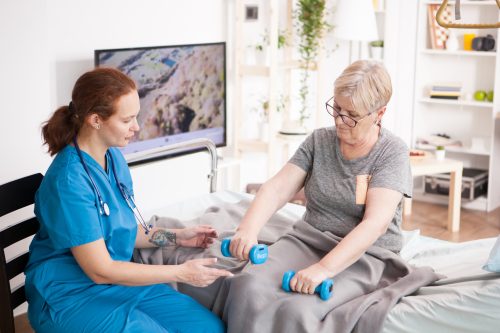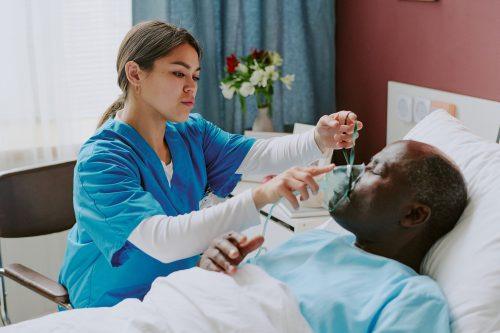Restorative nursing is an essential pillar of healthcare, dedicated to helping patients regain and maintain their physical and psychological well-being. With approximately 12.2% of adults in the United States facing mobility challenges, according to the CDC, the demand for effective restorative care has never been greater. For healthcare providers, these programs go beyond improving patient outcomes—they create a holistic and supportive care environment. Among the many benefits of restorative nursing, its transformative impact on patient mobility and independence stands out. This blog delves into the core principles of restorative nursing, highlights its far-reaching benefits, and offers actionable strategies for healthcare providers to implement or enhance such programs.
The Impact of Restorative Nursing on Patient Mobility and Independence

Restorative nursing is a specialized approach that bridges the gap between acute care and long-term rehabilitation. It is designed to maximize a patient’s abilities rather than focusing solely on their limitations. Its primary goals are:
- Promoting Physical Mobility: Encouraging activities that help patients regain strength, balance, and coordination.
- Enhancing Independence: Supporting patients in performing daily tasks with minimal assistance.
- Preventing Functional Decline: Mitigating the risks of muscle atrophy, joint stiffness, and other complications related to immobility.
- Boosting Emotional Well-being: Empowering patients with a sense of achievement and self-worth.
This approach is particularly beneficial for individuals recovering from surgeries, strokes, or chronic conditions, as well as for elderly patients in long-term care facilities.
The Role of Mobility in Patient Independence
Mobility is a cornerstone of independence. Being able to move independently—even in small ways—is essential for patients to manage their daily lives. However, reduced mobility can lead to a domino effect of challenges, including:
- Increased risk of pressure ulcers and blood clots.
- Reduced muscle strength and endurance.
- Higher dependence on caregivers, leading to decreased self-esteem.
- Social isolation and psychological distress.
Restorative nursing addresses these issues by implementing tailored interventions that focus on improving mobility, thus restoring a patient’s sense of autonomy.
Core Components of Restorative Nursing for Mobility

Individualized Care Plans
Each patient’s needs are unique. Restorative nursing begins with a comprehensive assessment of the patient’s physical abilities, medical history, and personal goals. Based on this evaluation, healthcare providers develop a personalized care plan that outlines specific mobility goals and the steps to achieve them.
Strengthening Exercises
Restorative nursing incorporates targeted exercises to build muscle strength and improve coordination. These may include:
- Range-of-motion exercises to maintain joint flexibility.
- Resistance training to increase muscle strength.
- Balance activities to reduce the risk of falls.
- Assistive Devices
Introducing assistive devices, such as walkers, canes, or wheelchairs, can significantly enhance a patient’s mobility. Restorative nurses ensure patients are properly trained to use these devices, promoting safety and confidence.
Gait Training
For patients with impaired walking abilities, gait training is a fundamental part of restorative nursing. This involves practicing walking techniques with or without assistive devices to improve stride, posture, and balance.
Functional Mobility Training
Restorative nursing emphasizes teaching patients how to perform real-life tasks, such as:
- Moving from a bed to a chair.
- Climbing stairs.
- Navigating uneven surfaces.
- Psychosocial Support
Addressing the emotional aspects of mobility loss is critical. Restorative nursing includes counseling and encouragement to help patients overcome fears, build resilience, and stay motivated.
Benefits of Restorative Nursing for Patients
Improved Physical Health
Regular movement and exercise reduce the risk of complications such as bedsores, blood clots, and muscle atrophy. Patients experience enhanced strength, endurance, and flexibility, which contribute to better overall health.
Enhanced Independence
By focusing on functional skills, restorative nursing empowers patients to perform daily activities with minimal assistance. This independence can significantly improve their quality of life.
Boosted Mental Health
Restorative nursing helps patients regain confidence and a sense of purpose. Achieving mobility goals can reduce feelings of helplessness and depression, fostering a positive outlook.
Prevention of Long-term Care Needs
For many patients, improved mobility can delay or even prevent the need for long-term care facilities. This not only benefits patients but also reduces the financial and emotional burden on families.
Implementing Restorative Nursing in Your Facility
For healthcare providers looking to incorporate or enhance restorative nursing practices, the following steps can serve as a guide:
Train Your Staff
Ensure your nursing team is well-versed in restorative care techniques. Provide ongoing training to keep them updated on best practices and new technologies.
Adopt a Team Approach
Restorative nursing works best when integrated into a multidisciplinary care model. Collaborate with physical therapists, occupational therapists, and physicians to provide comprehensive care.
Involve Patients and Families
Engage patients in setting their own mobility goals and involve their families in the care process. This fosters a sense of ownership and ensures continuity of care at home.
Monitor Progress
Use metrics and regular evaluations to track patient progress. Adjust care plans as needed to ensure patients are on the path to achieving their mobility goals.
Create a Supportive Environment
Design spaces within your facility that encourage movement, such as walking paths, exercise rooms, and accessible furniture. A supportive environment can motivate patients to stay active.
Overcoming Challenges
While restorative nursing offers numerous benefits, it is not without challenges. Common barriers include:
- Patient Resistance: Some patients may feel discouraged or unwilling to participate in mobility programs. Addressing these concerns with empathy and motivation is key.
- Resource Limitations: Facilities may face shortages of trained staff or equipment. Investing in training and seeking funding for necessary tools can mitigate these issues.
- Time Constraints: Busy schedules can limit the time staff can dedicate to restorative care. Streamlining workflows and prioritizing restorative nursing can help address this challenge.
The Future of Restorative Nursing
As healthcare evolves, restorative nursing is poised to become an even more integral part of patient care. Innovations such as virtual reality-based rehabilitation, robotic assistive devices, and telehealth services are already enhancing restorative practices. For healthcare providers, staying abreast of these advancements is crucial to delivering the best possible care.
Conclusion
Restorative nursing is a specialized approach that bridges the gap between acute care and long-term rehabilitation, focusing on improving patient mobility, independence, and emotional well-being. By implementing individualized care plans, strengthening exercises, gait training, assistive devices, and psychosocial support, healthcare providers can significantly enhance patient outcomes. The benefits extend beyond physical health—patients gain confidence, independence, and a better quality of life, while families experience reduced financial and emotional burdens.
For healthcare providers, the key to success lies in staff training, fostering a multidisciplinary approach, involving patients and families, and creating supportive environments. Overcoming challenges like resource limitations or patient resistance requires empathy, investment in training, and streamlined workflows. As innovations like virtual reality rehabilitation and telehealth continue to transform restorative nursing, adopting these practices ensures that providers stay at the forefront of modern healthcare while delivering exceptional care and building trust with patients.
Enroll your team in our customized, free course development program today at American Medical Compliance. Click here.



